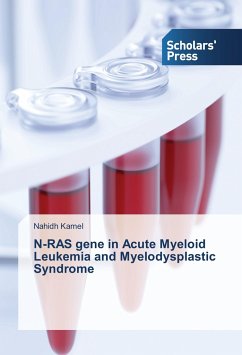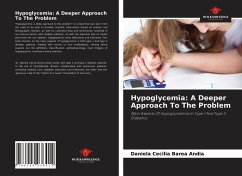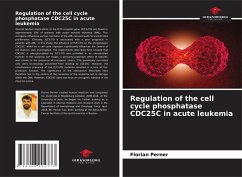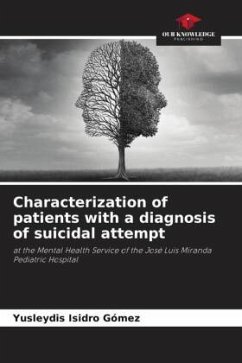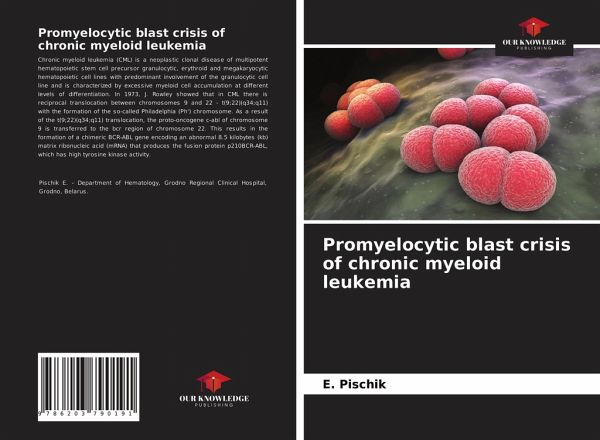
Promyelocytic blast crisis of chronic myeloid leukemia
Versandkostenfrei!
Versandfertig in 6-10 Tagen
24,99 €
inkl. MwSt.

PAYBACK Punkte
12 °P sammeln!
Chronic myeloid leukemia (CML) is a neoplastic clonal disease of multipotent hematopoietic stem cell precursor granulocytic, erythroid and megakaryocytic hematopoietic cell lines with predominant involvement of the granulocytic cell line and is characterized by excessive myeloid cell accumulation at different levels of differentiation. In 1973, J. Rowley showed that in CML there is reciprocal translocation between chromosomes 9 and 22 - t(9;22)(q34;q11) with the formation of the so-called Philadelphia (Ph') chromosome. As a result of the t(9;22)(q34;q11) translocation, the proto-oncogene c-abl...
Chronic myeloid leukemia (CML) is a neoplastic clonal disease of multipotent hematopoietic stem cell precursor granulocytic, erythroid and megakaryocytic hematopoietic cell lines with predominant involvement of the granulocytic cell line and is characterized by excessive myeloid cell accumulation at different levels of differentiation. In 1973, J. Rowley showed that in CML there is reciprocal translocation between chromosomes 9 and 22 - t(9;22)(q34;q11) with the formation of the so-called Philadelphia (Ph') chromosome. As a result of the t(9;22)(q34;q11) translocation, the proto-oncogene c-abl of chromosome 9 is transferred to the bcr region of chromosome 22. This results in the formation of a chimeric BCR-ABL gene encoding an abnormal 8.5 kilobytes (kb) matrix ribonucleic acid (mRNA) that produces the fusion protein p210BCR-ABL, which has high tyrosine kinase activity.
Chronic myeloid leukemia (CML) is a neoplastic clonal disease of multipotent hematopoietic stem cell precursor granulocytic, erythroid and megakaryocytic hematopoietic cell lines with predominant involvement of the granulocytic cell line and is characterized by excessive myeloid cell accumulation at different levels of differentiation. In 1973, J. Rowley showed that in CML there is reciprocal translocation between chromosomes 9 and 22 - t(9;22)(q34;q11) with the formation of the so-called Philadelphia (Ph') chromosome. As a result of the t(9;22)(q34;q11) translocation, the proto-oncogene c-abl of chromosome 9 is transferred to the bcr region of chromosome 22. This results in the formation of a chimeric BCR-ABL gene encoding an abnormal 8.5 kilobytes (kb) matrix ribonucleic acid (mRNA) that produces the fusion protein p210BCR-ABL, which has high tyrosine kinase activity.
Chronic myeloid leukemia (CML) is a neoplastic clonal disease of multipotent hematopoietic stem cell precursor granulocytic, erythroid and megakaryocytic hematopoietic cell lines with predominant involvement of the granulocytic cell line and is characterized by excessive myeloid cell accumulation at different levels of differentiation. In 1973, J. Rowley showed that in CML there is reciprocal translocation between chromosomes 9 and 22 - t(9;22)(q34;q11) with the formation of the so-called Philadelphia (Ph') chromosome. As a result of the t(9;22)(q34;q11) translocation, the proto-oncogene c-abl of chromosome 9 is transferred to the bcr region of chromosome 22. This results in the formation of a chimeric BCR-ABL gene encoding an abnormal 8.5 kilobytes (kb) matrix ribonucleic acid (mRNA) that produces the fusion protein p210BCR-ABL, which has high tyrosine kinase activity.








